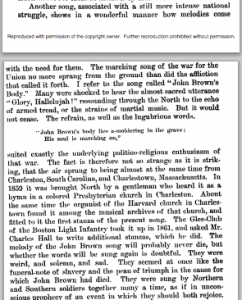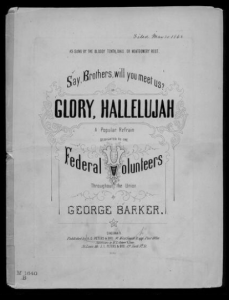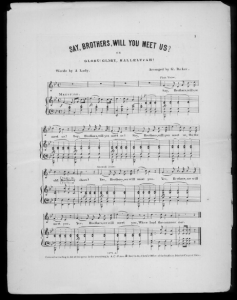In modern society, copyrights prove claims to authorship in music. In the past, too, great songwriters are immortalized as the formants of a genre–Cole Porter and George Gershwin are among the composers who churned out music to popular consumption. However, folk songs are traditionally passed along orally, and often authors are lost amidst the many additions and changes. Does embellishing and editing a previous author’s work remove the credibility and culture of the original message of a piece?
https://www.youtube.com/watch?v=XUzE1WeMc2g
“The Battle Hymn of the Republic” is typically a piece played in a militaristic style–a strong brass section, lots of snare drums, and in this YouTube clip, an obnoxious animated American flag. Its patriotism is not a new appropriation, but rather began during the Civil War when marching soldiers of both sides sang what was then “John Brown’s Body.” Although the John Brown the lyrics were written for was a soldier of the Massachusetts regiment and therefore a Civil War figure (PBS), he was not the one immortalized in the song. Rather, the abolitionist John Brown became the martyr the lyrics remember.
Both sides of the war sang this song, changing the words to fit their message (Library of Congress). But perhaps it is most appropriate that the northerners, with their message of freedom for the slaves, won the war and the song, as it had descended from fragments sung at ring shouts by the very slaves themselves.
According the Helen Kendrick Johnson and The North American Review, the earlier version of this tune was found in a “colored Presbyterian church in Charleston.”
Say, Brothers
Say, brothers, will you meet us (3x)
On Canaan’s happy shore.
(Refrain)
Glory, glory, hallelujah (3x)
For ever, evermore!
The score for this hymn is not the complete beginning of “Glory Hallelujah,” but rather only the version sung by congregations at revivalist meetings and in stricter church settings. Some scholars attribute the musical phrases and lyrics to ring shouts (Soskis 24-5). It is easy to imagine the call-and-response singing of the Biblical lyrics, along with interjections of “Glory, hallelujah!” In addition, the same message of escape, travel, and lands of ‘happy shores’ is evident in this piece as in many other slave songs.
Like many folk songs, spirituals, and hymns of early America, authorship is highly disputed. Claims of ownership come from many different sources, and usually the privileged, educated members of society have the most lasting paper trails. But the strong presence of a black musical tradition is evident in the very roots of music in America. White Northerners may have appropriated the traditional tunes and modified the lyrics, but it is a grand image to imagine soldiers singing a song reminiscent of the cause of freedom to its very core.
SOURCES:
“History of ‘John Brown’s Body,'” PBS. 2010. Web. http://www.pbs.org/wgbh/amex/brown/sfeature/song.html
Johnson, Helen Kendrick. The North American Review. May 1884. Accessed from Proquest.
Library of Congress. http://www.loc.gov/item/ihas.200000841/
Linder, Douglas O. “Famous Trials,” University of Missouri-Kansas City School of Law. 2015. Web. http://law2.umkc.edu/faculty/projects/ftrials/johnbrown/brownbody.html.
Soskis, Benjamin and John Stauffer. “The Battle Hymn of the Republic: A Biography of the Song that Marches On.” Oxford University Press, 9 May 2013. http://books.google.com/books?id=bIRQpD3HNSAC&dq=%22will+you+meet%22&source=gbs_navlinks_s




M, the story you sketch here gets at so many of the issues and repertories we’re talking about this semester: camp-meeting tunes, oral transmission of folk music, separate-but-somewhat-similar musical traditions among black and white church congregations, music’s use as a political or propaganda tool… the list goes on and on!
I’m not sure it’s quite fair to cast this as an example of whites appropriating black music, since the tune is documented back to the 1700s among Revival camp meetings. It’s perhaps better characterized as one of the few tunes black and white congregations both preserved, which is interesting in itself. And Helen Kendrick Johnson’s article is fascinating for wanting to give credit to the black church in Charleston where she believes the song originated (even though we know today that it is much older). So you’re on the right track here, even if the conclusions you draw seem like a bit of a stretch.
For your next post, try to do more of your own analysis of a primary source document, rather than briefly introducing it but otherwise providing mostly background information that you glean from internet sources. (If you do want to give some background, check out a book or reputable music encyclopedia first, rather than googling.) Keep up the good work!